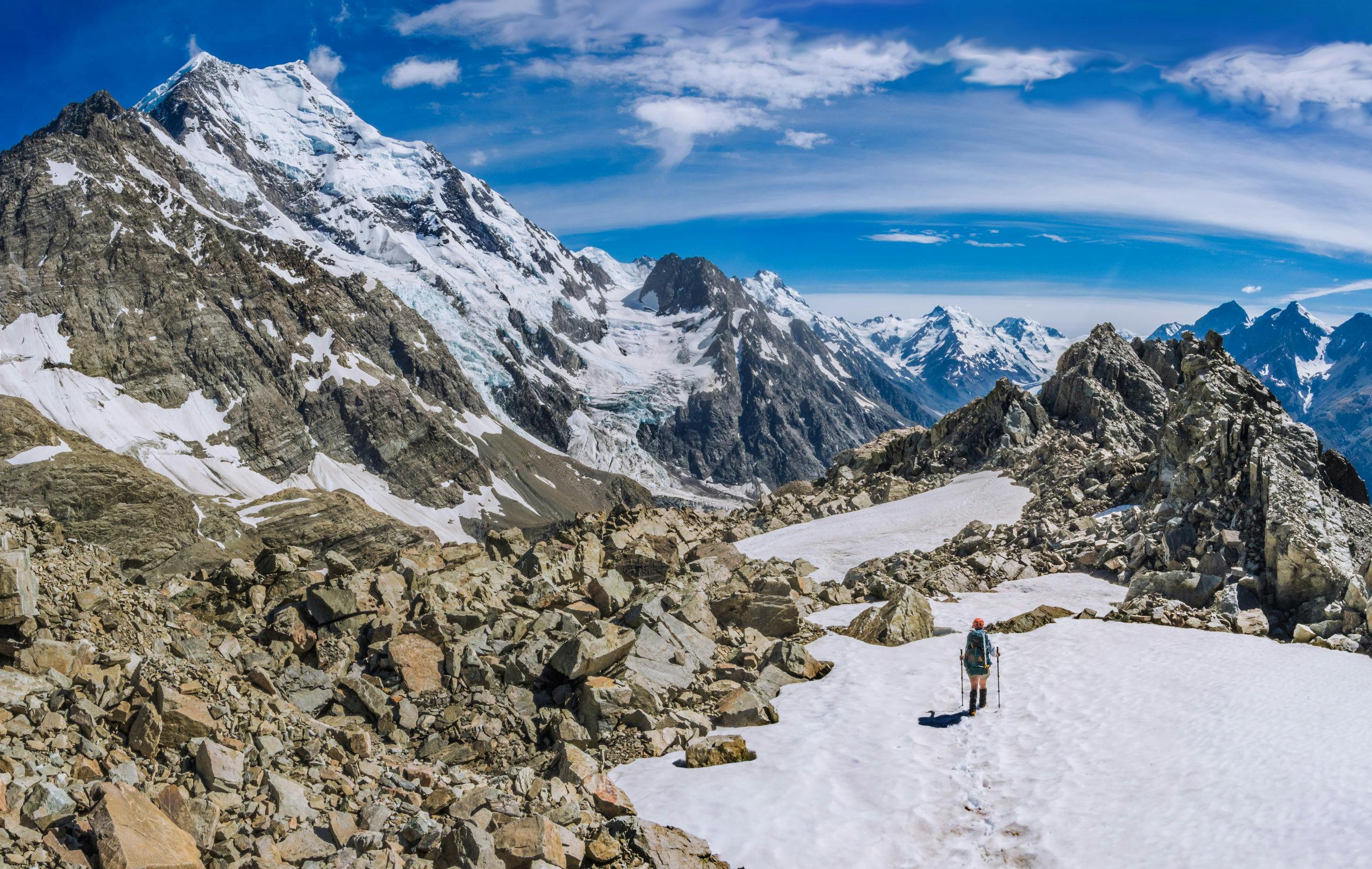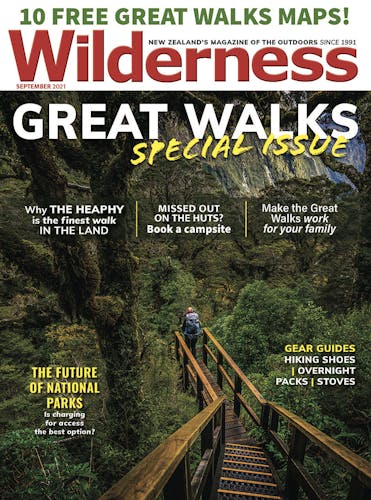Ball Pass has long been touted as one of those once in a lifetime trips. For Hazel Phillips, it’s a oncer, full stop. But that doesn’t mean you shouldn’t go.
If you continue with mountaineering, my snowcraft course instructor informed us, eventually you’d be skilled enough to attempt something like Ball Pass.
I’d never heard of Ball Pass but it remained in my head long after the course finished, lingering as a one-day possibility. If I ever managed to become good enough.
Eventually, I looked it up, knowing enough to deduce that the route went up the Hooker Glacier, over the pass on the Kirikiritata/Mt Cook Range and down the Tasman Glacier (or vice versa). The lack of any marked track on the map put it into a category of its own: serious stuff.
Years later, while staying at Mt Cook Village, I learned that erosion was increasingly a problem around the local glaciers and the Ball Pass route risked becoming cut off. I’d been to Ball Hut on the Tasman side of the route both before and after the massive washouts at Husky Flat in 2019. Seeing the erosion there, doing Ball Pass felt impossible. I’d never do it. It was beyond my capabilities, and anyway, the whole route was close to becoming consigned to history. Wasn’t it?
Then three days of perfect weather coincided with tramping buddy Simon getting three days off work. He’d done the route several times, as recently as six weeks previously; he knew it well.
And so I found myself up the Hooker Valley, clinging to branches, swearing at a recalcitrant shrub and glaring at Simon, who found the whole thing hilarious.
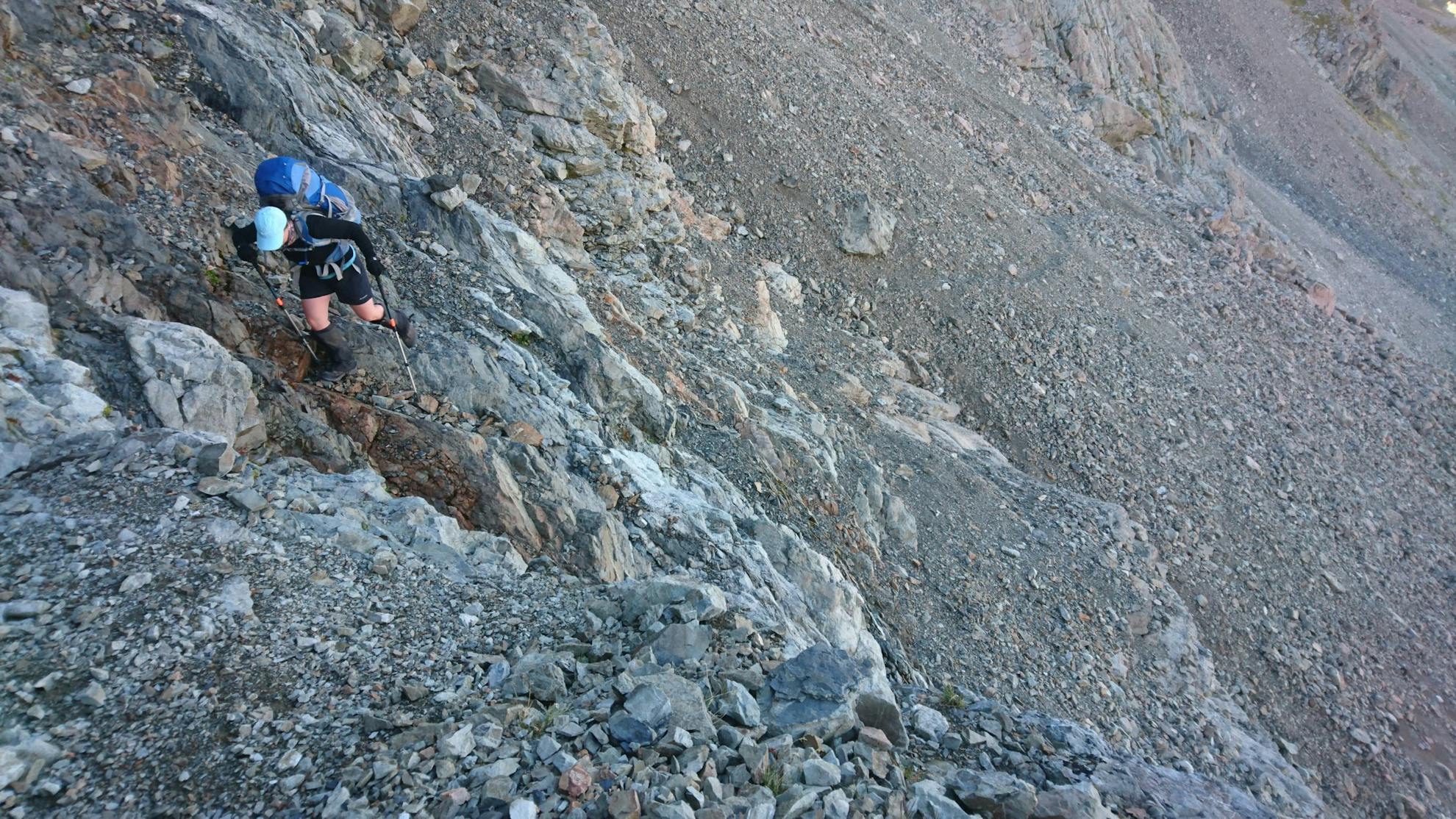
A Kiwi classic
Ball Pass was first reached in 1882 by two Swiss mountaineers who were trying to find a way onto the South Ridge of Aoraki/Mt Cook for their Irish client, the Reverend W.S. Green. In turn, Green named the glacier adjacent to Ball Pass ‘Ball Glacier’ after the first president of the English Alpine Club, John Ball. (So much for New Zealandness.)
Eight years later, well-known climbers Arthur Harper and George Mannering made the first successful crossing of Ball Pass, returning to The Hermitage this way.
And in 1892, the first woman crossed Ball Pass: American tourist Mrs Fairbanks crossed with guide Thomas Fyfe (who, two years later, was in the first party to summit Aoraki). They’d achieved it in two days, overnighting at Ball Hut then leaving at 4.30am and arriving back at The Hermitage at 6.45pm.
‘There is nothing remarkable in the feat for a man, but there are few ladies who would attempt the venture,’ a newspaper report of her crossing declared.
The route became a Kiwi classic, taking the hardy tramper, or mountaineer, along the eastern terraces of the Hooker Glacier moraine, up the gut leading to the Playing Fields, a large flat area, over the pass and down Ball Ridge to Ball Hut. Then essentially a road bash down the Tasman; buses used to go up and down the Ball Road and vestiges of that well-worn route can still be enjoyed in places.
And there I was, clinging to the shrub while verbally abusing it for its stubborn shrubbiness. My profanity and abuse were unfair, I admit; it is surely within the average shrub’s KPIs to remain steadfast against all elements, human or otherwise. I couldn’t reasonably blame the shrub for holding me in place, disallowing me any movement either forward or back. A sheer drop below raised the stakes. Any slip or inattention could result in a slide down the chasms of erosion that ended in a dip in the Hooker Lake.
Eventually, I won against the resilient and hardy shrub and Simon suppressed his mirth as we proceeded to the base of the steep gut leading to the Playing Fields. The track up the Hooker Valley is damaged now with huge chunks simply gone, requiring trampers to cross by ascending up and around each miniature disaster. It’s a tiring task. By comparison, the instability of the terrain up the gut was a simpler affair: two steps forwards, one step back.
Around 4pm, we reached the Playing Fields where we set up camp, keeping a careful watch for kea whose beaks would joyfully shred our tent. There are expansive views from the Playing Fields of the Hooker Glacier and Aoraki and over towards Mueller Hut on the Sealy Range. Sunset is a visual eruption.
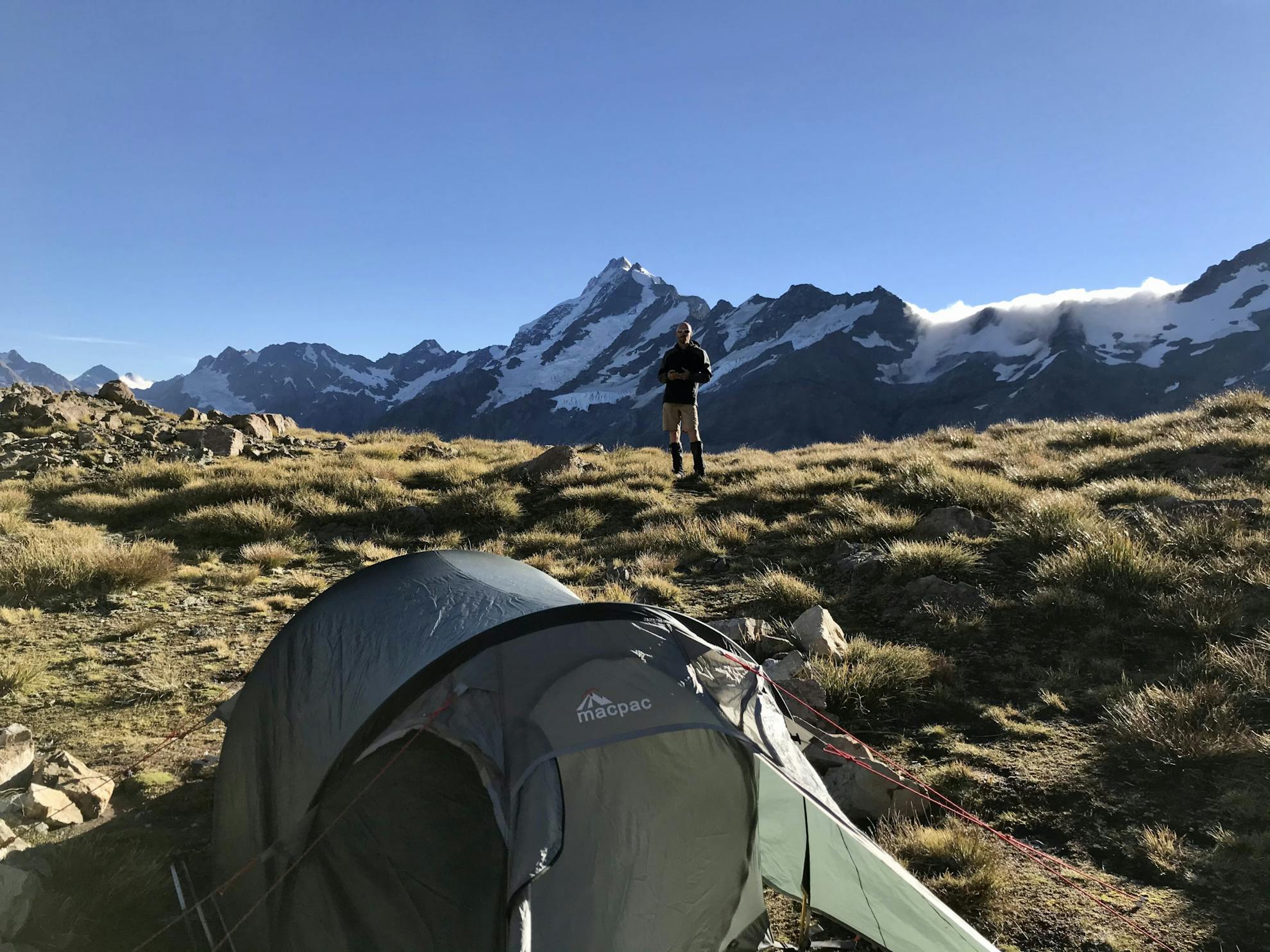
The next day we follow traces of a cairned trail on a zig-zag through the bluffs and around the corner towards Ball Pass, which is uncharacteristically devoid of snow. The bare scree is challenging to ascend but the views from the pass are worth it; huge sweeping vistas up the far Tasman Glacier to Hochstetter Dome and back down the Hooker Valley to the Hooker Track, no doubt crawling with Instagramming tourists.
We jump crevasses on the Ball Glacier, inspect a small meltwater lake, and lunch on the ridge above Caroline Hut. At one point above Caroline, ropes have been fixed to aid the descent – a terrifying prospect.
“You’re going to lose your s*** when we get to that point,” Simon says gleefully. By this point, I’ve already lost it several times – not just with that shrub but also with a short downclimb from the pass. But, I have nothing left to lose and manage to navigate it without any swearing or abuse. Simon, meanwhile, occasionally imitates me by yelling out “bastard shrub” and chuckling demonically.
Caroline Hut provides us with much-needed water and a sensible place for a break. The ridge is deceptively tricky as there are multiple ways to descend, and I’m thankful to be following someone who knows the way. Even still, we occasionally peer down potential rock scrambles to check the route. You wouldn’t want to be attempting it in low cloud or darkness.
Icefalls and avalanches cascade off the nearby faces as we descend, thundering through the still, cold air. I am so tired, my feet so sore, my legs so fatigued, that occasionally after taking a big step down, my body sits itself down for a rest despite my will. But I don’t linger for long; if I stop I won’t get started again.
Finally we reach Ball Hut, the small red shelter on the moraine terrace above the Tasman Glacier. I’m a wreck, and I lie, like a stunned slug, on the thin green mattresses inside, snacking on sugary treats. Simon calls my sugar stash ‘cocaine’. Anything to numb the pain, and maybe get a bit high.
But it’s done, I’ve finally conquered Ball Pass, the Holy Grail for snowcrafters. Sitting inside Ball Hut, cheeks filled with jelly beans, I decide I will never do this trip, ever again. Partly because of the washouts, which might cut off the route permanently. Partly because it’s utter madness. And partly because there’s no way I’d ever get such epic conditions.
I manage to summon enough energy to walk out the next day, including the new 220m climb and shrub-bash over the spur above the Husky Flat washout. This, too, threatens to become completely impassable.
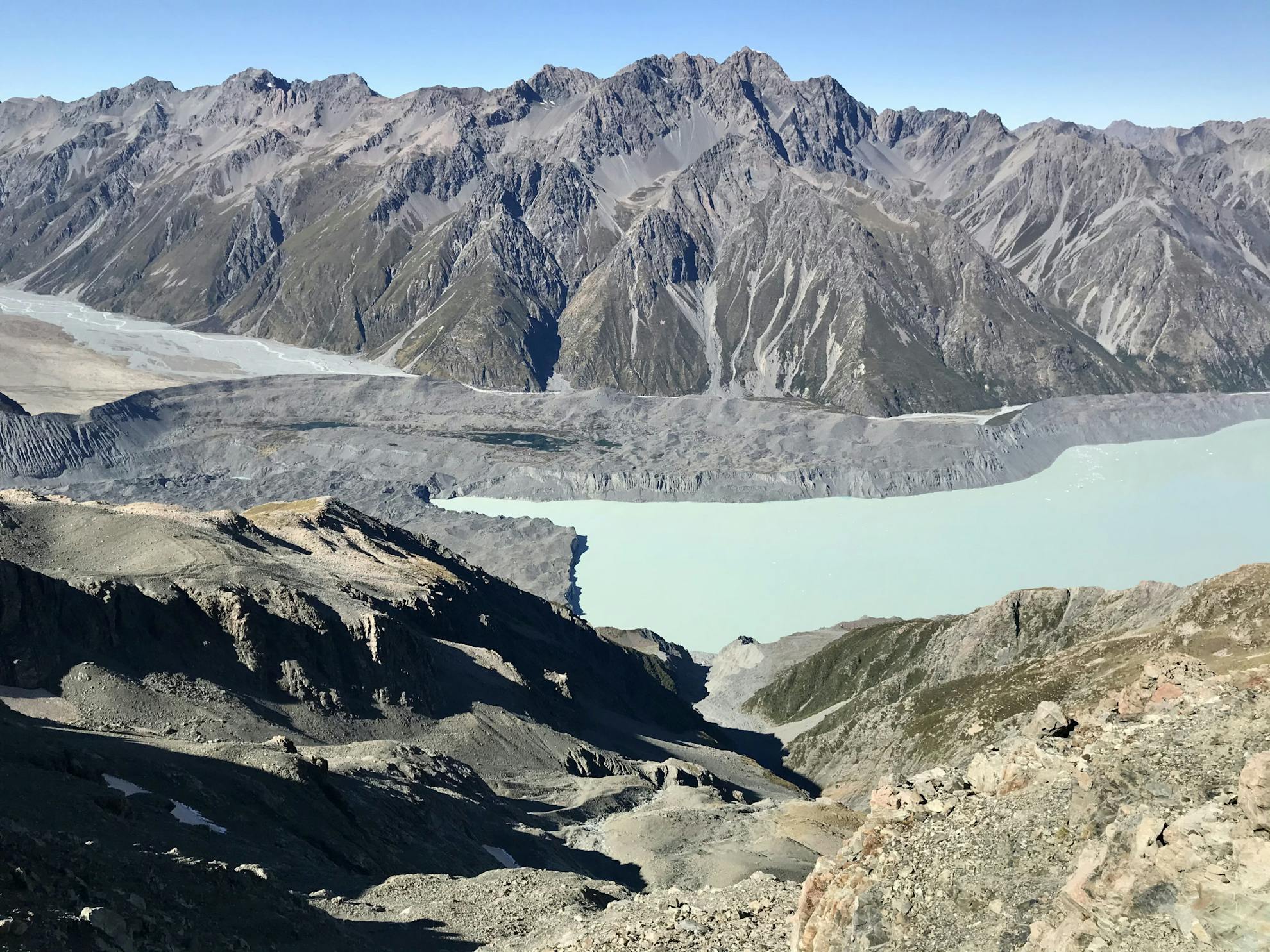
New route
In 1910, climber George Mannering and his wife Lucy found a new route over Kirikiritata/Mt Cook Range slightly south of Ball Pass. Climbing from the Tasman side below the Ball Pass track and constantly trending to the left, they found a better route with a far more splendid view of the Hooker Glacier than that from Ball Pass. (On the same trip, the party discovered a tunnel beneath the Tasman Glacier that went 70-80m below the surface. The surrounding ice went from brilliant blue to absolute darkness. It was planned to return with lanterns for greater exploration, but nothing further was ever reported.)
A similar route to Mannering’s now seems to be in use to get around the Hooker erosion issues by savvy, experienced locals. The round trip ascends on the true right of Cove Stream from Husky Flat, climbs a glacier between Mt Rosa and Mt Mabel and crosses a saddle between the two peaks to reach the bluff zig-zag just above the Playing Fields. It then follows the regular Ball Pass route over the pass and down Ball Ridge. It’s an appealing option, given it avoids bastard shrubs in the Hooker Valley but still takes in all the best terrain and views. For safety reasons, it’s best to check with knowledgeable locals before attempting it.
Guiding company Alpine Recreation, which owns Caroline Hut on Ball Ridge, is still offering the Ball Pass route to clients, also using a new route over Mabel Col. Alpine Recreation says it’s complex terrain. The route finding is tricky – harder than the traditional Ball Pass route – and best avoided in winter due to avalanche risk.
It seems, in spite of the violent erosion, Ball Pass will continue to be enjoyed by the persistent few.
(The map below shows the old route over Ball Pass and is meant only to give readers an idea of the location of the route.)
- Distance
- 26.8km
- Total Ascent
- 2242m
- Grade
- Difficult
- Time
- Hooker Valley to Playing Fields, 6hr; To Ball Pass, 2-3hr; To Ball Hut, 4hr; To road end, 4hr
- Accom.
- Ball Hut ($5, three bunks)
- Access
- Whitehorse Hill campground, near Mt Cook Village, or Tasman road end if going in the opposite direction
- Map
- BX15





